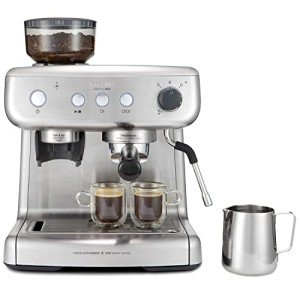The No. One Question That Everyone Working In Italian Espresso Machines Should Be Able To Answer
Heat Exchange Espresso Machines: A Comprehensive Guide
Espresso machines have actually progressed considerably for many years, accommodating the needs of home baristas and coffee experts alike. Among these machines, heat exchange espresso machines have gotten popularity due to their ability to provide constant performance and remarkable brew quality. In this short article, we will explore the functions, advantages, and important functions of heat exchange espresso machines, supplying a thorough understanding for both possible purchasers and coffee enthusiasts.
Comprehending Heat Exchange Technology
Heat exchange espresso machines operate on an unique concept that permits synchronised water heating for developing and steaming. They are equipped with a single boiler that makes use of a heat exchanger system. This feature is significant as it allows users to brew espresso while steaming milk simultaneously, promoting efficiency in the coffee-making procedure.
How Does a Heat Exchange Espresso Machine Work?
The procedure starts with the machine's water inlet filling the boiler. As the water warms up, it turns to steam. Buy Espresso Coffee Machines uses hot steam to heat extra water in a different passage developed specifically for the brew group. This implies that water can reach the ideal developing temperature level without awaiting the boiler to change. The key steps include:
- Water Fill: Water is drawn into the boiler.
- Heating Process: The boiler warms up as water is converted into steam.
- Heat Exchange: Steam warms water in the heat exchanger tube.
- Brewing: Water from the heat exchanger is pressed through coffee premises, extracting the flavors required for a rich espresso.
This procedure permits quick temperature level adjustments and enhanced coffee extraction.
Advantages of Heat Exchange Espresso Machines
Heat exchange espresso machines use numerous advantages, particularly for those wanting to optimize their coffee experience. Here are some crucial benefits:
- Simultaneous Brewing and Steaming: Users can brew espresso while steaming milk, making it ideal for hectic cafes and home baristas who value efficiency.
- Temperature Stability: The boiler's steam pressure assists preserve a stable temperature, which is important for constant espresso extraction.
- Versatility: The style permits for quick switching between developing and steaming, making it much easier to develop different coffee beverages, from lattes to coffees.
- User-friendly: Models frequently include available controls, making it possible for both newbies and skilled baristas to produce quality drinks.
- Professional Quality: Heat exchange machines are typically utilized in commercial settings, supplying users with high-quality developing efficiency in the house.
Key Features to Look for in Heat Exchange Espresso Machines
When considering the purchase of a heat exchange espresso machine, there are a number of features that a person must take into consideration:
- Build Quality: Look for machines made from long lasting materials, such as stainless steel or brass, making sure durability.
- Boiler Size: A bigger boiler will hold more water and sustain greater output gradually.
- PID Temperature Control: This feature helps maintain constant brew temperatures, which can enhance the coffee-making process.
- Group Head Design: Machines with a saturated or semi-saturated group head provide better temperature stability.
- Ease of Use: User-friendly user interfaces and intuitive controls improve the total experience for baristas at all skill levels.
- Steam Wand Quality: A good steam wand with proper insulation and versatility permits better texturing of milk.
- Water Reservoir Size: Depending on your requirements, consider how typically you wish to refill the water reservoir.
Contrast of Popular Heat Exchange Espresso Machines
To better understand the options offered in the market, below is a contrast table of some popular heat exchange espresso machines:
Machine Model
Boiler Size
PID Control
Cost Range
User Ratings
Profitec Pro 700
2.0 L
Yes
₤ 2,000-₤ 2,500
9.5/ 10
Rocket Espresso R58
1.8 L
Yes
₤ 2,400-₤ 2,800
9.4/ 10
Elekta Bianca
1.8 L
Yes
₤ 2,500-₤ 3,000
9.6/ 10
La Spaziale S1 Vivaldi II
1.5 L
Yes
₤ 1,800-₤ 2,200
9.2/ 10
Bezzera Magica
1.2 L
No
₤ 1,600-₤ 1,800
9.0/ 10
FAQs About Heat Exchange Espresso Machines
What is the main difference in between a heat exchange and a dual boiler espresso machine?
While both types can brew espresso and steam milk at the exact same time, dual boiler machines have different boilers for developing and steaming. In contrast, heat exchange machines make use of a single boiler and a heat exchanger to accomplish the same function.
Are heat exchange machines ideal for novices?
Yes! Many heat exchange machines are developed with user-friendly features, making them accessible for beginners. With proper guidance and practice, users can quickly produce quality espresso.
What sort of maintenance do heat exchange espresso machines require?
Regular maintenance consists of descaling, cleaning up the boiler, checking seals and gaskets, and keeping the group head tidy. Regular maintenance ensures longevity and constant performance.
Can I use a heat exchange machine for different types of coffee drinks?
Definitely! Heat exchange machines allow users to create a range of coffee beverages, consisting of espresso, lattes, coffees, and more.
Heat exchange espresso machines represent a mix of innovation and tradition, offering coffee enthusiasts with the tools required for crafting the best cup. Their ability to concurrently brew and steam, combined with exact temperature control, makes them an engaging choice for both home baristas and experts. With the ideal knowledge on functions and upkeep, users can open a world of splendid coffee experiences, making sure that each sip is as wonderful as the last.
